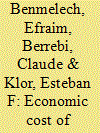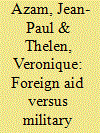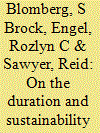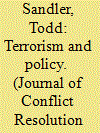|
|
|
Sort Order |
|
|
|
Items / Page
|
|
|
|
|
|
|
| Srl | Item |
| 1 |
ID:
094736


|
|
|
|
|
| Publication |
2010.
|
| Summary/Abstract |
The authors model a terrorist organization's choice over the scale and planning horizon of terror attacks and the consequences for the organization's evolution. The organization can engage in short-term attacks planned and executed in a single period, characterized by a low fixed cost and relatively high marginal cost, and longer term attacks planned and executed over two periods, having a high fixed cost but relatively low marginal cost. Longer term attacks require more resources and cause more damage if successful. Successful attacks increase the organization's size; in addition, the organization has a natural growth rate. Attacks can fail because of failed execution or counterterror interdiction. In a two-period version of this model, the authors analyze the terror organization's attack decisions. They use simulations to characterize optimal strategies and explore their implications for the growth of the organization. The authors identify a set of strategic regimes, and the results show that they always occur in a fixed order as a function of the organization's initial strength.
|
|
|
|
|
|
|
|
|
|
|
|
|
|
|
|
| 2 |
ID:
094738


|
|
|
|
|
| Publication |
2010.
|
| Summary/Abstract |
The literature on conflict and terrorism has paid little attention to the economic costs of terrorism for the perpetrators. This article aims to fill that gap by examining the economic costs of harboring suicide terror attacks. Using data covering the universe of Palestinian suicide terrorists during the second Palestinian uprising, combined with data from the Palestinian Labor Force Survey, the authors identify and quantify the impact of a successful attack on unemployment and wages. They find robust evidence that terror attacks have important economic costs. The results suggest that a successful attack causes an increase of 5.3 percent in unemployment, increases the likelihood that the district's average wages fall in the quarter following an attack by more than 20.0 percent, and reduces the number of Palestinians working in Israel by 6.7 percent relative to its mean. Importantly, these effects are persistent and last for at least six months after the attack.
|
|
|
|
|
|
|
|
|
|
|
|
|
|
|
|
| 3 |
ID:
094732


|
|
|
|
|
| Publication |
2010.
|
| Summary/Abstract |
This article presents a theoretical framework and some empirical results showing that the level of foreign aid received reduces the supply of terrorist attacks from recipient countries, while U.S. military interventions are liable to increase this supply. Due account is taken of endogeneity problems in producing these results. They suggest that Western democracies, which are the main targets of terrorist attacks, should invest more funds in foreign aid, with a special emphasis on supporting education, and use military interventions more sparingly.
|
|
|
|
|
|
|
|
|
|
|
|
|
|
|
|
| 4 |
ID:
094734


|
|
|
|
|
| Publication |
2010.
|
| Summary/Abstract |
The authors analyze the optimal network structure of two types of terrorist organizations. In the centralized network, the leadership selects the level of individual effort and the level of group connectivity so as to maximize the expected net welfare of the organization's membership. Leaders in loosely connected networks will also seek to balance the trade-off between security and communications. However, with decentralized decision making, the individual nodes may not make optimal decisions from the group's perspective. As a consequence, the decentralized decision-making process is suboptimal from the overall perspective of the network. In particular, the leadership in a centralized network is able to coordinate the activities of all network members and to take advantage of important network externalities.
|
|
|
|
|
|
|
|
|
|
|
|
|
|
|
|
| 5 |
ID:
094737


|
|
|
|
|
| Publication |
2010.
|
| Summary/Abstract |
This article aims to improve scholars' understanding of how transnational terrorist organizations emerge, survive, thrive, and eventually die.The authors use a data set that catalogues terrorist organizations and their attacks over time (the ITERATE database of thousands of terrorist events from 1968 through 2007) and merge those data with socioeconomic information about the environment in which each attack occurs. They use these data to trace the life cycle pattern of terrorist activity and the organizations that perpetrate them. They identify at least two types of terrorist organizations- recidivists and one-hit wonders. The authors find that recidivist organizations, those that have repeatedly attacked, are less likely to survive once political and socioeconomic factors have been included. However, they find that sporadic or one-hit wonders are not easily deterred by socioeconomic factors, leaving open a role for counterinsurgency tactics.
|
|
|
|
|
|
|
|
|
|
|
|
|
|
|
|
| 6 |
ID:
094730


|
|
|
|
|
| Publication |
2010.
|
| Summary/Abstract |
This article sets the stage for the special issue by indicating the current focus in the literature on applying analytical tools to enlighten policy makers in the practice of counterterrorism in the post-9/11 era. In particular, the article briefly indicates the main areas of recent work. The article also introduces some key concepts. Next, the article highlights the methodology and main contributions of each of the seven articles of the special issue. The novelty and policy insights of each article are emphasized.
|
|
|
|
|
|
|
|
|
|
|
|
|
|
|
|
| 7 |
ID:
094739


|
|
|
|
|
| Publication |
2010.
|
| Summary/Abstract |
This article presents a signaling model of terrorist attacks, where the target government faces a trade-off from its counterterrorism responses and the backlash (counterreaction) that such responses incite. An endogenous characterization of terrorist spectaculars is specified, given a government's counterterrorism stance and the potential for backlash attacks. In particular, spectacular attacks are pooling, rather than separating, phenomena, whereby the government cannot discern, based on past attacks, the militancy of the terrorist group. The definition for ''spectacular'' terrorist attacks is inversely related to the government's toughness and its belief that it confronts a militant group. Policy recommendations are specified for non-event-specific intelligence in relation to the avoidance of spectacular attacks or unnecessary concessions. Intelligence must be focused on the propensity for counterterrorism to give rise to a backlash attack.
|
|
|
|
|
|
|
|
|
|
|
|
|
|
|
|
| 8 |
ID:
094731


|
|
|
|
|
| Publication |
2010.
|
| Summary/Abstract |
This article utilizes Bayesian Poisson changepoint regression models to demonstrate how transnational terrorists adjusted their target choices in response to target hardening. In addition, changes in the collective tastes of terrorists and their sponsorship have played a role in target selection over time. For each of four target types- officials, military, business, and private parties-the authors identify the number of regimes and the probable predictors of the events. Regime changes are tied to the rise of modern transnational terrorism, the deployment of technological barriers, the start of state sponsorship, and the dominance of the fundamentalists. The authors also include two sets of covariates-logistical outcome and victim's nature-to better explain the dynamics. As other targets have been fortified and terrorists have sought greater carnage, private parties have become the preferred target type. In recent years, terrorists have increasingly favored people over property for all target types. Moreover, authorities have been more successful at stopping attacks against officials and the military, thereby motivating terrorists to attack business targets and private parties.
|
|
|
|
|
|
|
|
|
|
|
|
|
|
|
|
|
|
|
|
|